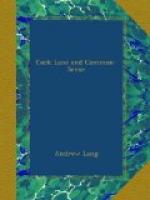These arguments, then, make in favour of the old-fashioned theory of ghosts and wraiths, as things objectively existing, which is very comforting to a conservative philosopher. Unluckily, just as many, or more, anecdotes look quite the other way. For instance, General Barter sees, hears, and recognises the dead Lieutenant B., wearing a beard which he had grown since the general saw him in life. He also sees the hill-pony ridden by Mr. B., and killed by him—a steed with which, in its mortal days, the general had no acquaintance. This is all very well: a dead pony may have a ghost, like Miss A. B.’s dog which was heard by one Miss B., and seen by the other, some time after its decease. On mature reflection, as both ladies were well-known persons of letters, we suppress their names, which would carry the weight of excellent character and distinguished sense. But Lieutenant B. was also accompanied by two grooms. Now, it is too much to ask us to believe that he had killed two grooms, as he killed the pony. {207b} Consequently, they, at least, were hallucinations; so what was Lieutenant B.? When Mr. K., on board the Racoon, saw his dead father lying in his coffin (p. 461), there was no real coffin there, at all events; and hence, probably, no real dead father’s ghost,—only a ‘telepathic hallucination’. Miss Rose Morton could never touch the female ghost which she often chased about the house, nor did this ghost break or displace the threads stretched by Miss Morton across the stairs down which the apparition walked. Yet its footsteps did make a noise, and the family often heard the ghost walking downstairs, followed by Miss Morton. Thus this ghost was both material and immaterial, for surely, only matter can make a noise when in contact with matter. On the whole, if the evidence is worth anything, there are real objective ghosts, and there are also telepathic hallucinations: so that the scientific attitude is to believe in both, if in either. And this was the view of Petrus Thyraeus, S.J., in his Loca Infesta (1598). The alternative is to believe in neither.




